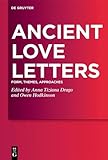Ancient Love Letters : Form, Themes, Approaches / ed. by Anna Tiziana Drago, Owen Hodkinson.
Material type: TextPublisher: Berlin ; Boston : De Gruyter, [2023]Copyright date: ©2023Description: 1 online resource (VII, 331 p.)Content type:
TextPublisher: Berlin ; Boston : De Gruyter, [2023]Copyright date: ©2023Description: 1 online resource (VII, 331 p.)Content type: - 9783110999693
- 9783110989496
- 9783110989472
- 886.0109
- PN6140.L7 A53 2023
- online - DeGruyter
- Issued also in print.
| Item type | Current library | Call number | URL | Status | Notes | Barcode | |
|---|---|---|---|---|---|---|---|
 eBook
eBook
|
Biblioteca "Angelicum" Pont. Univ. S.Tommaso d'Aquino Nuvola online | online - DeGruyter (Browse shelf(Opens below)) | Online access | Not for loan (Accesso limitato) | Accesso per gli utenti autorizzati / Access for authorized users | (dgr)9783110989472 |
Frontmatter -- Table of Contents -- Introduction -- Part 1 The ‘Grammar’ of the Epistolary Genre: Structural Perspectives -- Chapter 1 Greco-Roman Love Letters and Modern Genre Theory -- Chapter 2 Mapping Some of the Generic Borders of the Greek Love Letter -- Chapter 3 The Body and the Letter -- Chapter 4 Letters Before Letters -- Part 2 Intertextuality: Literary Models, Topoi, Conventions, Imitative Strategies -- Chapter 5 Lookin’ for Love (in Plato’s Epistles) -- Chapter 6 The Structure and Ordering of the Philostratean Love Letters -- Chapter 7 Hyperliterarity, Intertextuality and Formalized Erotic Language. The Letters of Aristaenetus -- Chapter 8 Philostratus’ Erotic Epistles and Latin Elegy Revisited -- Chapter 9 Sealed with a Curse: Elegy, Epistolography, and Magic Ritual in Ovid Heroides 6 -- Part 3 Cultural Issues and Backgrounds -- Chapter 10 Alciphron: The Erotic Letters in the Spotlight -- Chapter 11 Epistolarity, Eroticism, and Agency: The Female Voice in Fictional Greek Love Letters -- Chapter 12 Is Diogenes in Love with a Eunuch? The Destabilising Power of Erōs in the Letters of Theophylact Simocatta -- Chapter 13 In a Sentimental Mood? Love, Sex, Marriage (and Other Catastrophes) in Personal Letters (and Everyday Documents) from Graeco-Roman Egypt -- Bibliography -- Notes on Contributors -- Index Nominum -- Index Rerum -- Index Locorum
restricted access online access with authorization star
http://purl.org/coar/access_right/c_16ec
This volume investigates the form of love letters and erotic letters in Greek and Latin up to the 7th Century CE, encompassing both literary and documentary letters (the latter inscribed and on papyrus), and prose and poetry. The potential for, and utility of treating this large and diverse corpus as a ‘genre’ is examined. To this end, approaches from ancient literary criticism and modern theory of genre are made; mutual influences between the documentary and the literary form are sought; and origins in proto-epistolary poetic texts are examined. In order to examine the boundaries of a form, limit cases, which might have less claim to the label ‘love letter’, are compared with more clear-cut examples. A series of case studies focuses on individual letters and letter-collections. Some case studies situate their subjects within the history and literary evolution of the love letter, using both intertextuality and comparative approaches; others placing them in their cultural and historical contexts, particularly uncovering the contribution of epistolarity to erotic discourse, and to the history of sexuality and gender in diverse eras and locations within Classical to Late Antiquity.
Issued also in print.
Mode of access: Internet via World Wide Web.
In English.
Description based on online resource; title from PDF title page (publisher's Web site, viewed 06. Mrz 2024)


